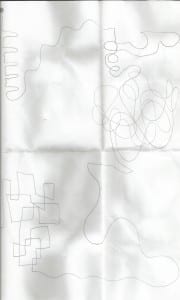Thick Skinning and Impulse Part 2.
In realising last week that an internal focus prevented me from effectively thick skinning, this week I ‘opened my eyes’. I became more aware and observant of my partner moving around in the space allowing me to trace her.
So what happens when the one thing you rely on is taken away from you?
Emphatic choreography happens, “co-built relational activity that emerges from dance improvisation” (Riberiro and Fonseca, 2011, 81) I realise that I do not need to actively see my partner to sense or know where she is. We developed a shared sense of meaning, and an understanding for how each of us moves around in the space.
The thing that I noticed in impulse this week is that where an impulse is received tends to remain the same. The same:
Shoulder
Arm
Leg
Head
Hip
How can this change before the concept loses its impact?
The person sending the impulse can change the body part they send the impulse with.
With this new addition I felt that I was using my entire body more, I was sending impulses into my partner with body parts that I would not have thought to use previously.
The movement felt more connected, I could use the body part that was most readily available to me, rather than relying on a hand that hinders movement efficiency.
Thomas Lehmen’s Funktionen
There is a material maker. They put the movement in the space.
The interpreter interprets the movement of the material maker.
The manipulator adapts the movement being performed, changing their space or prevent them from execution an action.
The observer watches what is happening in the space.
The mediator asks questions to the performers and audience about what they see in the space. (Husemann, 2005, 32)
Cycle 1 – each of the above must happen in a chronological order.
Cycle 2 – after each role has entered the space, the performers may leave and enter as a new role.
This score seemed quite challenging, largely because it was so different to all the scores we had done previously. However, when performing the score I was quite surprised.
I found myself deviating toward two particular roles, material maker and manipulator.
For material maker I liked the idea of bringing something new to the space and showing something different from what was already there. If I found that the pace was quite slow, I could bring in quicker movement or contrasting dynamics.
For manipulator, I liked the idea of getting in the way of someone’s intentions, forcing them to change or adapt their movement accordingly.
I steered away from the other roles, the mediator role in particularly, I found the prospect of talking on a microphone quite daunting.
The actual role of a mediator was however quite interesting, asking questions allowed me, the audience and other performers to easily see what was going on in the space, and the different relationships between the performers.
It’s the wrong week to tackle attachment.
The Jam.
Thomas Lehmen’s Funktionen score was used again for this jam, it followed the exact same principals as the last. Though where the movement came from differed from previous weeks. The movement was personal to me, it came from a map of my life.
We would then use the pathway as inspiration and the movement would develop from what happened at the different point in my life.
As said in the previous week, I need to able let go of the attachment I feel to my movement. Due to the nature of this score/improvisation this was not possible. I had a personal connection to the movement, so there was no way I could become unattached to what I was doing.
Becoming unattached is still my goal.
Husemann, P. (2005) The Functioning of Thomas Lehmen’s Funktionen. Dance Theatre Journal, 21 (1) 31-35.
Ribeiro, M. M. and Fonseca, A. (2011) The empathy and the structuring sharing modes of movement sequences in the improvisation of contemporary dance. Research in Dance Education, 12 (2) 71-85.
